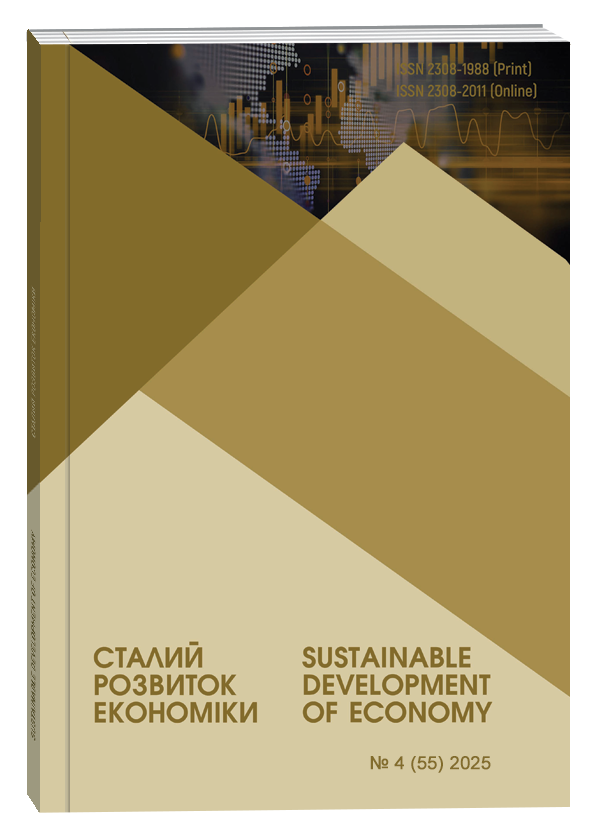DETERMINANTS FOR THE DEVELOPMENT OF A CIRCULAR BIOECONOMY: METHODOLOGICAL AND APPLIED ASPECTS
Abstract
The article provides a comprehensive methodological substantiation of the determinants and catalysts of circular bioeconomy development. The research clarifies the semantic content of the concept of “determinant” and classifies its components according to causal and functional levels. A conceptual hierarchy of determinants is proposed, which integrates socio-ecological-economic imbalances as systemic drivers, biotechnological innovations as causal mechanisms, bioresource potential as a structural indicator, the decoupling effect as a functional condition, and sustainable development as a strategic objective. Particular attention is paid to the role of biomass as a renewable resource that constitutes the material basis of bioeconomic systems. The paper presents a classification of biomass types and directions of their utilization within the circular model, emphasizing their capacity to form closed loops of value creation. Additionally, the article highlights the color-based typology of biotechnologies, which reflects their functional segmentation across agriculture, industry, medicine, aquaculture, environmental protection, and bioinformatics. Institutional and innovation-related catalysts of transformation are analyzed, including regulatory support, public-private partnerships, targeted green investments, and the expansion of knowledge and competences in the field of bioeconomy. The research also systematizes stakeholder interactions within a polycentric governance model, emphasizing the complementary roles of business structures, state institutions, academia, and society in promoting bio-based production and consumption. The findings suggest that consideration of determinants and catalysts forms a conceptual foundation for the development of a competitive, resource-efficient, and socially responsible model of circular bioeconomy in Ukraine. The practical implications include strengthening national energy independence, ensuring food security, reducing dependence on fossil resources, and supporting the sustainable development of rural regions. The results contribute to the academic discourse on bioeconomy by combining methodological systematization with applied recommendations, which can be utilized in designing national strategies, regulatory frameworks, and innovative projects aimed at accelerating the transition to a circular bioeconomy paradigm.
References
Bugge M. M., Hansen T., Klitkou A. What is the bioeconomy? A review of the literature. Sustainability. 2016. Vol. 8. Issue 7. P. 691. DOI: https://doi.org/10.3390/su8070691
DaSilva E. J. The Colours of Biotechnology: Science, Development and Humankind. Electronic Journal of Biotechnology. 2004. Vol. 7. Issue 3. P. 1–2. URL: https://www.ejbiotechnology.info/index.php/ejbiotechnology/article/view/1114
European Commission. A Sustainable Bioeconomy for Europe: Strengthening the Connection Between Economy, Society and the Environment. Luxembourg: Publications Office of the European Union, 2018. DOI: https://doi.org/10.2777/792130
European Commission. Circular Economy Action Plan: For a cleaner and more competitive Europe. Brussels: European Union, 2020. URL: https://eur-lex.europa.eu/legal-content/EN/TXT/?uri=CELEX:52020DC0098
European Commission. The European Green Deal. Brussels: European Union, 2019. URL: https://eur-lex.europa.eu/legal-content/EN/TXT/?uri=CELEX:52019DC0640
Geissdoerfer M., Savaget P., Bocken N. M. P., Hultink E. J. The Circular Economy – A new sustainability paradigm? Journal of Cleaner Production. 2017. Vol. 143. P. 757–768. DOI: https://doi.org/10.1016/j.jclepro.2016.12.048
Ghisellini P., Cialani C., Ulgiati S. A review on circular economy: the expected transition to a balanced interplay of environmental and economic systems. Journal of Cleaner Production. 2016. Vol. 114. P. 11–32. DOI: https://doi.org/10.1016/j.jclepro.2015.09.007
Kafarski P. Rainbow code of biotechnology. Chemik. 2012. Vol. 66. No. 8. P. 811–816. URL: https://journals.indexcopernicus.com/publication/300734
Kirchherr J., Reike D., Hekkert M. Conceptualizing the circular economy: An analysis of 114 definitions. Resources, Conservation and Recycling. 2017. Vol. 127. P. 221–232. DOI: https://doi.org/10.1016/j.resconrec.2017.09.005
Kucher O., Hutsol T., Glowacki S., Andreitseva I., Dibrova A., Muzychenko A., Kocira S. Energy potential of biogas production in Ukraine. Energies. 2022. Vol. 15. Issue 5. P. 1710. DOI: https://doi.org/10.3390/en15051710
OECD. The Bioeconomy to 2030: Designing a Policy Agenda. Paris: OECD Publishing, 2009. DOI: https://doi.org/10.1787/9789264056886-en
Rizos V., Behrens A., Van der Gaast W., Hofman E., Ioannou A., Kafyeke T., Topi C. Implementation of circular economy business models by small and medium-sized enterprises (SMEs): Barriers and enablers. Sustainability. 2016. Vol. 8. Issue 11. P. 1212. DOI: https://doi.org/10.3390/su8111212
United Nations Environment Programme (UNEP). Decoupling natural resource use and environmental impacts from economic growth. Nairobi: UNEP, 2011. URL: https://www.resourcepanel.org/reports/decoupling-natural-resource-use-and-environmental-impacts-economic-growth
United Nations. Convention on Biological Diversity. 1992. URL: https://www.cbd.int/doc/legal/cbd-en.pdf
Wozniak E., Twardowski T. The bioeconomy in Poland within the context of the European Union. New Biotechnology. 2018. Vol. 40. P. 96–102. URL: https://www.researchgate.net/publication/317788928_The_Bioeconomy_in_Poland_within_the_Context_of_the_European_Union
Байдала В. В. Формування системи показників оцінки рівня розвитку біоекономіки в Україні. Збірник наукових праць Таврійського державного агротехнологічного університету (економічні науки). 2014. № 1(25). С. 32–36. URL: http://nbuv.gov.ua/UJRN/znptdau_2014_1_8
Закон України «Про альтернативні види палива» № 1391-VI від 21.05.2009. URL: https://zakon.rada.gov.ua/laws/show/1391-14#Text
Закон України «Про альтернативні джерела енергії» № 555-IV від 20.02.2003. URL: http://zakon5.rada.gov.ua/laws/show/555-15
Закон України «Про управління відходами» № 2320-IX від 20.06.2022. URL: https://zakon.rada.gov.ua/laws/show/2320-20#Text
Михайленко О. Г., Гордієнко О. О. Нова економічна модель та сучасні тенденції розвитку підприємництва. Економіка і менеджмент 2019: перспективи інтеграції та інноваційного розвитку: зб. наук. праць Міжнар. наук.-практ. конф., 18–19 квіт. 2019. Дніпро: Біла К. О., 2019. Т. 8. С. 62–65.
Міжнародна фінансова корпорація. Результати опитування: Ринкові умови для впровадження проектів виробництва енергії з біомаси в Україні [Електронний ресурс]. 2020. URL: https://saee.gov.ua/static-objects/saee/sites/1/Files/Korysni%20Publikacii/ifc-survey.pdf
Що таке біомаса? Біоенергетична асоціація України (UABio). 2020. URL: https://uabio.org/news/7609/
Bugge, M. M., Hansen, T., & Klitkou, A. (2016). What is the bioeconomy? A review of the literature. Sustainability, 8(7), 691. https://doi.org/10.3390/su8070691
DaSilva, E. J. (2004). The Colours of Biotechnology: Science, Development and Humankind. Electronic Journal of Biotechnology, 7(3), 1–2. https://www.ejbiotechnology.info/index.php/ejbiotechnology/article/view/1114
European Commission. (2018). A Sustainable Bioeconomy for Europe: Strengthening the Connection Between Economy, Society and the Environment. Luxembourg: Publications Office of the European Union. https://doi.org/10.2777/792130
European Commission. (2020). Circular Economy Action Plan: For a cleaner and more competitive Europe. Brussels: European Union. https://eur-lex.europa.eu/legal-content/EN/TXT/?uri=CELEX:52020DC0098
European Commission. (2019). The European Green Deal. Brussels: European Union. https://eur-lex.europa.eu/legal-content/EN/TXT/?uri=CELEX:52019DC0640
Geissdoerfer, M., Savaget, P., Bocken, N. M. P., & Hultink, E. J. (2017). The Circular Economy – A new sustainability paradigm? Journal of Cleaner Production, 143, 757–768. https://doi.org/10.1016/j.jclepro.2016.12.048
Ghisellini, P., Cialani, C., & Ulgiati, S. (2016). A review on circular economy: The expected transition to a balanced interplay of environmental and economic systems. Journal of Cleaner Production, 114, 11–32. https://doi.org/10.1016/j.jclepro.2015.09.007
Kafarski, P. (2012). Rainbow code of biotechnology. Chemik, 66(8), 811–816. https://journals.indexcopernicus.com/publication/300734
Kirchherr, J., Reike, D., & Hekkert, M. (2017). Conceptualizing the circular economy: An analysis of 114 definitions. Resources, Conservation and Recycling, 127, 221–232. https://doi.org/10.1016/j.resconrec.2017.09.005
Kucher, O., Hutsol, T., Glowacki, S., Andreitseva, I., Dibrova, A., Muzychenko, A., & Kocira, S. (2022). Energy potential of biogas production in Ukraine. Energies, 15(5), 1710. https://doi.org/10.3390/en15051710
OECD. (2009). The Bioeconomy to 2030: Designing a Policy Agenda. Paris: OECD Publishing. https://doi.org/10.1787/9789264056886-en
Rizos, V., Behrens, A., Van der Gaast, W., Hofman, E., Ioannou, A., Kafyeke, T., & Topi, C. (2016). Implementation of circular economy business models by small and medium-sized enterprises (SMEs): Barriers and enablers. Sustainability, 8(11), 1212. https://doi.org/10.3390/su8111212
United Nations Environment Programme (UNEP). (2011). Decoupling natural resource use and environmental impacts from economic growth. Nairobi: UNEP. https://www.resourcepanel.org/reports/decoupling-natural-resource-use-and-environmental-impacts-economic-growth
United Nations. (1992). Convention on Biological Diversity. https://www.cbd.int/doc/legal/cbd-en.pdf
Wozniak, E., & Twardowski, T. (2018). The bioeconomy in Poland within the context of the European Union. New Biotechnology, 40, 96–102. https://www.researchgate.net/publication/317788928_The_Bioeconomy_in_Poland_within_the_Context_of_the_European_Union
Baidala, V. V. (2014). Formuvannia systemy pokaznykiv otsinky rivnia rozvytku bioekonomiky v Ukraini [Formation of an indicator system for assessing the level of bioeconomy development in Ukraine]. Zbirnyk naukovykh prats Tavriiskoho derzhavnoho ahrotekhnolohichnoho universytetu (ekonomichni nauky), 1(25), 32–36. (in Ukrainian)
Verkhovna Rada of Ukraine. (2009). Zakon Ukrainy “Pro alternatyvni vydy palyva” [Law of Ukraine “On alternative fuels”] No. 1391-VI, May 21, 2009. https://zakon.rada.gov.ua/laws/show/1391-14 (in Ukrainian)
Verkhovna Rada of Ukraine. (2003). Zakon Ukrainy “Pro alternatyvni dzherela enerhii” [Law of Ukraine “On alternative energy sources”] No. 555-IV, Feb 20, 2003. http://zakon5.rada.gov.ua/laws/show/555-15 (in Ukrainian)
Verkhovna Rada of Ukraine. (2022). Zakon Ukrainy “Pro upravlinnia vidkhodamy” [Law of Ukraine “On waste management”] No. 2320-IX, June 20, 2022. https://zakon.rada.gov.ua/laws/show/2320-20 (in Ukrainian)
Mykhailenko, O. H., & Hordiienko, O. O. (2019). Nova ekonomichna model ta suchasni tendentsii rozvytku pidpryiemnytstva [New economic model and modern trends in entrepreneurship development]. In Ekonomika i menedzhment 2019: perspektyvy intehratsii ta innovatsiinoho rozvytku (Vol. 8, pp. 62–65). Dnipro: Bila K. O. (in Ukrainian)
International Finance Corporation. (2020). Market conditions for biomass energy projects in Ukraine: Survey results. https://saee.gov.ua/static-objects/saee/sites/1/Files/Korysni%20Publikacii/ifc-survey.pdf (in Ukrainian)
UABio. (2020). Shcho take biomasa? [What is biomass?]. Bioenergy Association of Ukraine. https://uabio.org/news/7609/ (in Ukrainian)


